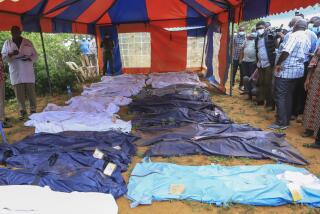Cult’s Believers Waiting for Judgment Day
- Share via
For 50 years, the cult involved in a violent and bloody shootout Sunday with federal agents near Waco, Tex., has been preoccupied with the long-foretold catastrophic end of time--an awful day of reckoning when the wicked would be brought to judgment.
But as federal agents stormed the cult’s armed fortress on Sunday, it was the group’s leader, David Koresh--a man who claims to be Jesus Christ--that agents of the Bureau of Alcohol, Tobacco and Firearms were attempting to bring to justice. The agents hoped to arrest him as they executed search warrants for guns and explosives.
When the smoke cleared Sunday, at least four ATF agents were dead and another 15 agents had been wounded. At least one cult omember was killed and several more were injured. At nightfall, the standoff continued, with up to 100 people, about a third of them children--holed up in the compound.
Koresh, 33, reportedly is believed by his followers to be the “lamb” referred to in the New Testament’s Book of Revelation (Chapter 5) and is the only one who can open the seven seals that unloose the judgment of God--wars, pestilence and other catastrophes--upon the Earth.
From its beginnings, the Branch Davidians, an offshoot of the Seventh-day Adventists, have been concerned--some would say obsessed--by the final days.
That concern had its roots in the Seventh-day Adventists, who originally expected the Second Coming of Christ to occur in 1844. Today, Seventh-day Adventists say the return of Christ is imminent, but they give no date.
The breakaway Branch Davidian group involved in Sunday’s shootout had its beginnings in 1929 when Victor Houteff, a prominent member of the church in Los Angeles, developed a following of his own and moved to Texas, and called the group the Shepherd’s Rod.
Other Seventh-day Adventists viewed Houteff’s group as eccentric, according to James R. Lewis of Goleta, who for the past 10 years has studied cults in the United States. He is affiliated with the nonprofit Assn. of World Academics for Religious Education, organized last year.
Lewis said that although Houteff’s group was not totally communal, they shared in a farm and had their own school and printing press.
At the beginning of World War II, Houteff changed the group’s name to Davidic Seventh-day Adventists. Ironically, Lewis said, Houteff believed that the Seventh-day Adventists were not passive enough because they allowed their members to serve in non-combative roles in the armed services.
When Houteff died in 1955 he was succeeded by his wife, Florence. Florence Houteff predicted that Christ would return on April 22, 1959, prompting hundreds of new followers to join the group after selling their property and businesses. Membership swelled to about 1,400.
When the hoped-for Second Coming failed to materialize, Florence Houteff stepped down and a new group emerged. Like cells dividing, the cult split again in 1959 and then again in 1984, with Koresh heading the Branch Davidians involved in Sunday’s shootout.
It was not the first time that a religious group obsessed by the end of the world had moved from a kind of spiritual apocalypse to a secular apocalypse.
Lewis said it is quite common to have a religious group that claims to have unique access to the truth. Many such groups are millenarian; they believe in the imminent end of history.
The Seventh-day Adventists come out of the tradition of expecting the advent or second advent of Christ. But there is no connection today between the Seventh-day Adventists and the group involved in the gun battle Sunday.
“The difference here is when you get into stockpiling arms,” said Lewis. “You probably have some kind of survivalist mentality in which you are thinking more of a secular collapse, a non-religious end of time in which the economy goes to pot and you’re going to have to defend yourself from non-believers around you,” Lewis said in an interview.
“It doesn’t happen a lot, but it’s something that happens with disturbing regularity,” Lewis said.
More to Read
Sign up for Essential California
The most important California stories and recommendations in your inbox every morning.
You may occasionally receive promotional content from the Los Angeles Times.













